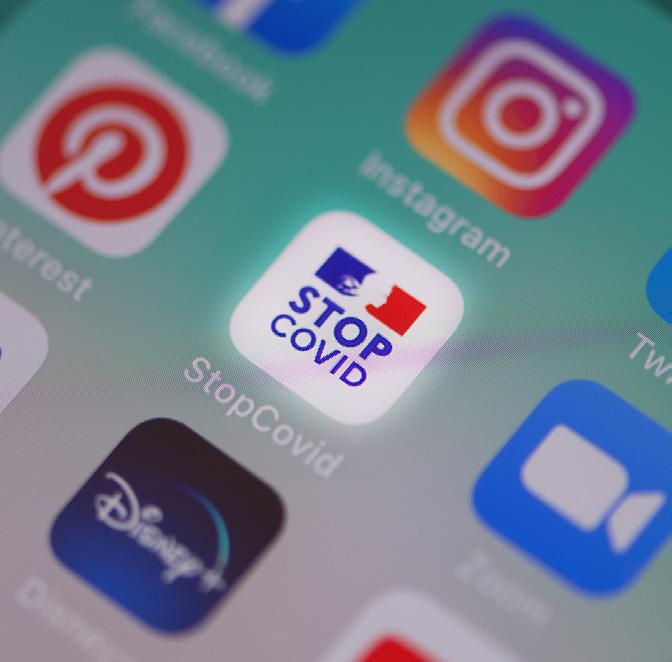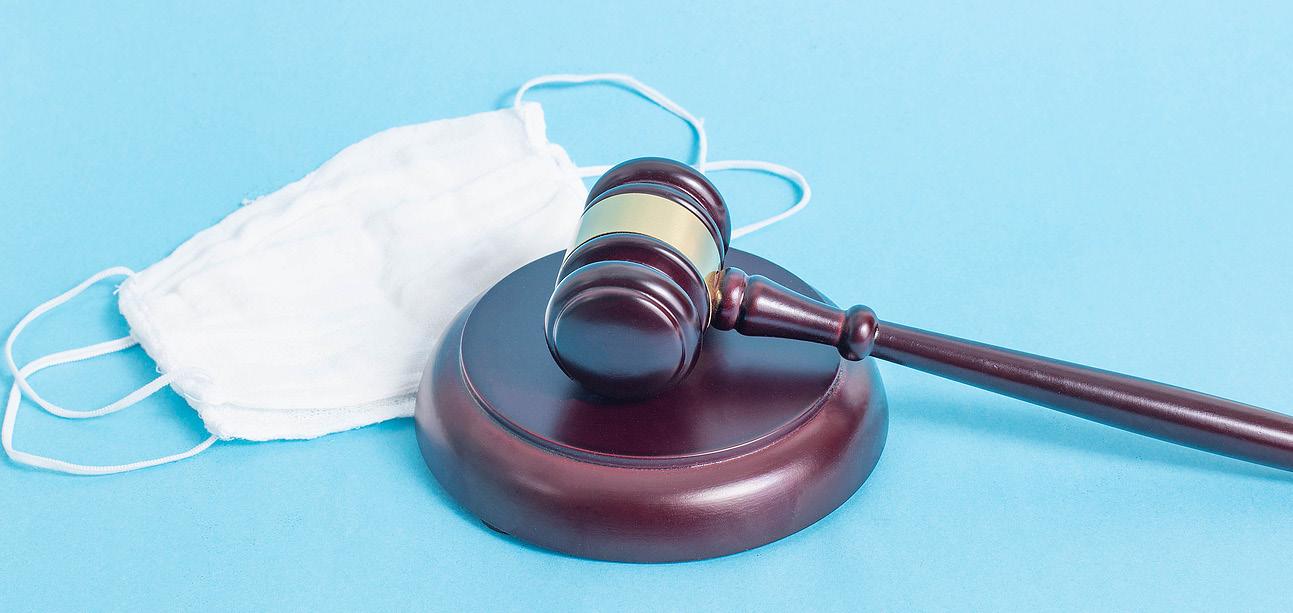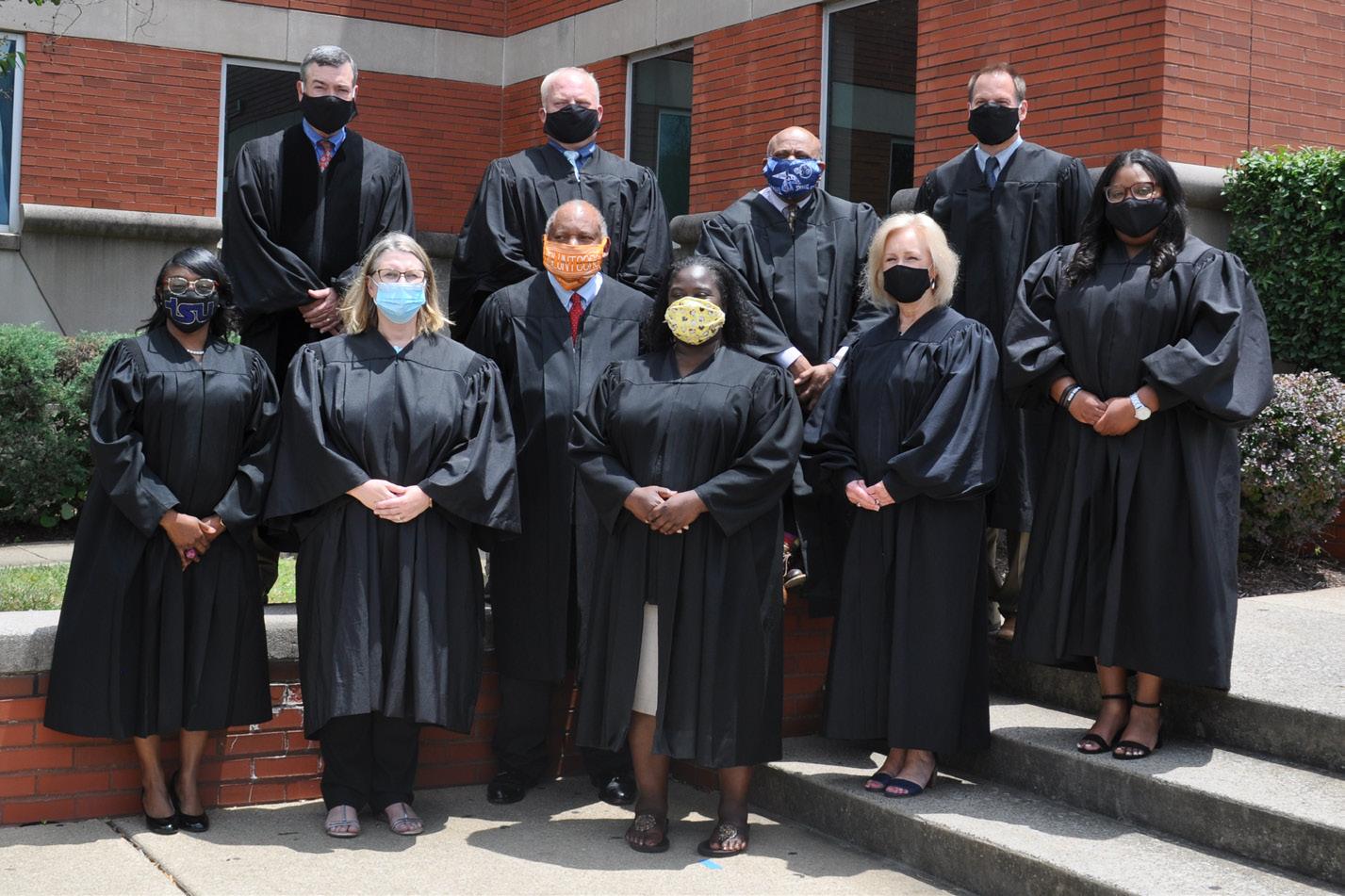
10 minute read
Gadget of the Month
BILL & PHIL’S GADGET OF THE MONTH Contact Tracing Apps | Bill Ramsey & Phillip Hampton
The global pandemic caused by the COVID-19 virus has had a huge impact on almost all aspects of our day-to-day lives. We have had to change the way we work, meet, socialize, and relax. Technology has been critical in helping us manage the life-work changes mandated by the pandemic. One new application of technology that has emerged is a tech-enabled method for an old practice known as “contact tracing.”
While the term “contact tracing” is new to many of us, the practice is quite old. Public health officials have been doing contact tracing for decades as a very effective means of stifling outbreaks of communicable diseases. Once a person is identified as having a highly contagious disease, he or she is interviewed by a public health worker to determine who the infected person has been in contact with while contagious. Those individuals are then contacted and advised to self-isolate and get tested. The idea is to stop the spread of the disease by re-tracing the steps of the infected person, and isolating those who were in close proximity before they have had a chance to potentially spread the disease to their circle of contacts. The practice of contact tracing has become even more important with COVID-19, as some carriers of the virus can be asymptomatic
and completely unaware that they may be infecting others around them.
So, how does technology change the way public health officials do contact tracing? It’s easy when you think about it. What is the one device that just about every one of us take with us virtually everywhere we go? Our smartphone. So, if someone tests positive for coronavirus, wouldn’t it be easy and save time for the contact tracers if that person’s phone had a record of all other phones (carried by people) that had been in close proximity to the infected individual over the past week or so? Yes. In theory, if smartphones could somehow keep a log of other phones that had been within six feet of the infected person’s phone, it could hypothetically go back and warn those other smartphone users that they had been potentially exposed to the virus. That is the idea behind using technology—and specifically smartphone technology—to conduct rapid contact tracing.
Apple and Google, who dominate the smartphone market, saw how useful smartphones could be in helping public health officials curtail the spread of the virus. In a rare joint venture, they developed a toolkit of sorts that app developers can use to build contact tracing apps. The Apple/Google toolkit, which works on both iPhone and Android phones, uses Bluetooth technology to automatically communicate with other smartphones within a certain proximity. A user would have to opt-in to the contact tracing app that uses this technology; but afterwards the system would work automatically without any prompting from the user.
So, if I had a contact tracing app on my phone that uses this technology, and I had opted-in to allow the tracing, my phone would emit a unique identifier using the Bluetooth signaling capability of the phone. Other smartphones that came within so many feet (say 6 feet) of my phone for a certain length of time (say 15 minutes) would record my unique identifier in their history log; and my phone would record their unique identifier in my phone’s history log. Then, if I happen to test positive for coronavirus, a public health official could take my phone and “see” the other phones that had been in close proximity to me within the past week. The public health official could then take those unique identifiers and automatically contact the users of those other phones via the app to let them know that they had been potentially exposed to the virus. What could go wrong?
Well, as it turns out, quite a few things could go wrong. First, for such a system to be effective, a large majority of the population would need to adopt it. A large majority of the population does indeed own a smartphone; but, so far, adoption of contact tracing apps has been nowhere near universal. While some countries have developed and released a universal contact tracing app for their citizens, the US has not developed—nor signaled intent to develop— any such federal app. Instead, the individual states have been left to develop contact tracing apps. Near the beginning of the pandemic, several states seemed eager to develop contact tracing apps for their citizens. As the pandemic has lingered, however, the promised contact tracing apps from state health officials have been few and far between. As of this writing, only three states—Alabama, North Dakota, and South Carolina— have requested access to the Apple/ (continued on page 20)

GET INVOLVED! GET EXPERIENCE! GET NOTICED!
Invest in your future... Meet lawyers across
Nashville—the networking is invaluable
in finding the career of your dreams.
Visit NashvilleBar.org/Join today!
JOIN THE NBA LAW STUDENT DIVISION
The NBA—with over 2,500 members—is the largest metropolitan bar association in Tennessee. Membership in the NBA My NBA membership provides me with many offers law students the opportunity to learn about the actual benefits including excellent CLE programs at practice of law through committee participation, discountconvenient locations and reasonable prices. ed CLE seminars, and publications. In addition, various It also provides opportunities to network with networking opportunities are available for those who members of our profession whom I otherwise participate in NBA activities. would not see but for NBA’s events, programs, and socials. Join online now at NashvilleBar.org/Join — Judge Frank Clement or complete the form on the reverse side of this flyer and return to the Nashville Bar Association at the address below. I’m a member of the NBA because its excellent programming makes me a better lawyer and because its social events make me a happier, more well-rounded professional.
—Erin Palmer Polly, NBA Past President
QUESTIONS?
Email Vicki.Shoulders@nashvillebar.org or call 615-242-9272 today!
Nashville Bar Association 150 4th Ave N, Ste 1050 Nashville, TN 37219 What I think makes the NBA stand out is its unique ability to draw together local lawyers and legal professionals from a variety of backgrounds and interests into one place. It brings together the broadest spectrum of lawyers who are also well-versed in Nashville’s jurisprudence. — Daniel Satterfield
Confrontation Rights & Public Trial During a Pandemic

Tennessee courts are formulating plans on how to conduct business in the age of social distancing. Which means eventually, we will be headed back to the courtroom for trials. But what does that look like? How do we ensure public access to the courtroom? How do we protect criminal defendants’ constitutional rights while preventing COVID-19? We do not presume to definitively answer to those questions, but existing case law may provide guidance.
The Confrontation Clause in the Age of COVID-19
How does one confront witnesses in a socially distant setting? Both the United States and Tennessee Constitutions guarantee the right to confrontation. 1 Indeed, the Tennessee Constitution says criminal defendants have the right to meet witnesses “face to face”.
The United States Supreme Court held in Maryland v. Craig that, although face-to-face confrontation is preferred, the federal Confrontation Clause does not require face-to-face meetings in all cases. 2 Courts may allow alternatives to in-person testimony if necessary to “further and important public policy” and when the reliability of testimony can be assured. 3 For example, in Craig, the Court held that a child to testifying via one-way close-circuit television feed satisfied confrontation. In short, confrontation is generally satisfied when the defendant can cross-examine the victim and the fact-finder can judge the witness’s credibility. 4
Conversely, Tennessee’s Constitution guarantees criminal defendants the right to meet witnesses “face to face”. There is some debate over whether the face-to-face language in the Tennessee Constitution affords criminal defendants more protection than they receive from the Federal Constitution. In State v. Deuter, the Tennessee Supreme Court observed in dicta that other states had interpreted the face-to-face language to impose a higher right than that found in the federal constitution. 5 However, in the end Deuter provided no guidance regarding the protection afforded by the Tennessee Constitution. In the years since Deuter, the Tennessee Supreme Court appears to have repeatedly rejected the suggestion that the face-to-face language in the Tennessee Constitution provides more protection than the US Constitution. 6 However, none of the cases since Deuter squarely presented the face-to-face confrontation
(continued on page 18)
issue to the Court.
The Tennessee Court of Criminal Appeals recently addressed the Confrontation Clause and possible use of remote testimony in State v. Seale. 7 In that case, the trial court held that outof-state prosecution witnesses could testify via two-way videoconferencing technology. The Court of Criminal Appeals acknowledged that Tennessee had adopted the same analysis as the federal courts when addressing confrontation issues under the state constitution. However, the Court held that testimony via two-way videoconferencing was not constitutionally equivalent to face-to-face confrontation. Therefore, before a witness may testify via twoway videoconferencing software, the trial court must conduct a Craig analysis and make case- and witness-specific findings about whether the denial of a face-to-face confrontation is necessary to further an important public interest. In short, “face-to-face confrontation in Tennessee means simply that, face-to-face communication, unless there is some greater public interest that overrides the directives of our great state’s constitution.” 8
The Right to a Public Trial in the Age of COVID-19
Prior to COVID-19, excluding citizens from the courtroom was risky business but the practical effect of the pandemic is a sharp reduction in the number of citizens allowed in the courtroom. The changes that accompany COVID-19 beg the question of how to balance the court’s directives aimed at improving public health with a defendant’s Sixth Amendment right to a public trial.
In the 2019 decision State v. Franklin, the Tennessee Court of Criminal Appeals overturned a child rape conviction because the defendant’s parents were barred from the courtroom when the four-year-old victim testified. 9 When the State requested, but put on no proof, that the courtroom should be closed when the victim testified, the trial court granted the request. The conviction was
Juvenile Court Judge Sheila Calloway and the Magistrates

overturned based on the Sixth Amendment’s right to a public trial as well as the Tennessee Constitution which ensures, “That in all criminal prosecutions, the accused hath the right to…a speedy public trial.” 10
The Franklin decision relied heavily on Waller v. Georgia in which the US Supreme Court set out four factors that must be shown by the party requesting courtroom closure: (1) there must be an overriding interest likely to be prejudiced; (2) the closure must be no broader than necessary to protect that interest; (3) the trial court must consider reasonable alternatives to closing the proceeding and; (4) it must make findings adequate to support closure. 11
Lastly, it is important to note a majority of federal circuits distinguish between a total closure of the courtroom and a situation where only partial closure to certain people is sought. 12 While both total and partial closures infringe upon a defendant’s constitutional right to a public trial, the Sixth Circuit Court of Appeals, in United States v. Simmons, joined the majority of circuits and adopted a modified Waller test for partial closures. In this modified test, the necessity of demonstrating an “overriding interest” is replaced by a “substantial reason” and the other three prongs of the Waller test remain the same. 13 However, it does not appear that Tennessee state courts have adopted the modified Simmons test, and the Franklin court applied the original Waller factors without mention of the modified Simmons test. 14
A packed courtroom is similar to the dance floor at a Broadway bar or a beach: if left unchecked, they can pose a threat in the spread of COVID-19.
(continued on page 24)






